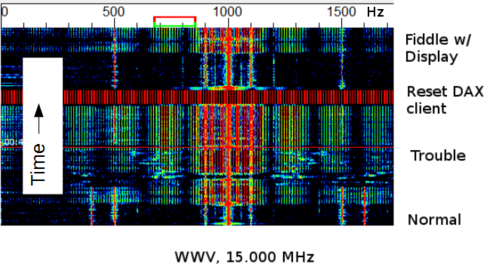Welcome to the new FlexRadio Community! Please review the new Community Rules and other important new Community information on the Message Board.
Need the latest SmartSDR, Power Genius, Tuner Genius and Antenna Genius Software?
SmartSDR v3.7.4 and the SmartSDR v3.7.4 Release Notes | SmartSDR v2.12.1 and the SmartSDR v2.12.1 Release Notes
SmartSDR v1.12.1 and the SmartSDR v1.12.1 Release Notes
Power Genius XL Utility v3.8.8 and the Power Genius XL Release Notes v3.8.8
Tuner Genius XL Utility v1.2.11 and the Tuner Genius XL Release Notes v1.2.11
Antenna Genius Utility v4.1.8
SmartSDR v3.7.4 and the SmartSDR v3.7.4 Release Notes | SmartSDR v2.12.1 and the SmartSDR v2.12.1 Release Notes
SmartSDR v1.12.1 and the SmartSDR v1.12.1 Release Notes
Power Genius XL Utility v3.8.8 and the Power Genius XL Release Notes v3.8.8
Tuner Genius XL Utility v1.2.11 and the Tuner Genius XL Release Notes v1.2.11
Antenna Genius Utility v4.1.8
If you are having a problem, please refer to the product documentation or check the Help Center for known solutions.
Need technical support from FlexRadio? It's as simple as Creating a HelpDesk ticket.
Need technical support from FlexRadio? It's as simple as Creating a HelpDesk ticket.
DAX receive gets into funny state (JT65)
Options

Martin AA6E
Member ✭✭✭
Running a '6700 with 1.3.8 software with DAX link to wsjt-x JT65 software. Using Win7 on a Core i7-920 system with GT640 graphics. We observe JT65 spectra sometimes get "fuzzy" with DAX, but the SSDR panafall is normal. See figure:

This is a wsjt-x spectrum of WWV at 15 MHz showing carrier and sidebands. This run begins at the bottom and goes upward in time. It starts normally, then the "bad" mode sets in. I can always get back to normal mode by exiting DAX client and restarting. You see the red band when there's no data -- I am doing the restart operation. Then follows a period of normal operation. But I can make it go bad again by twiddling the SSDR display parameters - changing black level quickly up and down, presumably loading the SSDR or the firmware. This is reproducible, but note that it only occurs "easily" when my CPU is loaded fairly heavily. (I have another job taking about 50% of CPU in the background.)
I do see this same effect with JT65 and without the extra CPU load, but it takes longer to go "bad". In every case, I've been able to fix it by restarting the DAX client.
I think others have reported something similar, but maybe this adds some useful info.
My hypothesis FWIW: the DAX transmission has a timing-dependent synchronization problem such that the low order bits get scrambled. The high order bits may be OK. The effect is less noticeable with weaker signals. There seem to be two states - "good" and "bad". I can usually flip back from bad to good by using the same trick as I used to make it go from good to bad, but DAX restart is easier.

This is a wsjt-x spectrum of WWV at 15 MHz showing carrier and sidebands. This run begins at the bottom and goes upward in time. It starts normally, then the "bad" mode sets in. I can always get back to normal mode by exiting DAX client and restarting. You see the red band when there's no data -- I am doing the restart operation. Then follows a period of normal operation. But I can make it go bad again by twiddling the SSDR display parameters - changing black level quickly up and down, presumably loading the SSDR or the firmware. This is reproducible, but note that it only occurs "easily" when my CPU is loaded fairly heavily. (I have another job taking about 50% of CPU in the background.)
I do see this same effect with JT65 and without the extra CPU load, but it takes longer to go "bad". In every case, I've been able to fix it by restarting the DAX client.
I think others have reported something similar, but maybe this adds some useful info.
My hypothesis FWIW: the DAX transmission has a timing-dependent synchronization problem such that the low order bits get scrambled. The high order bits may be OK. The effect is less noticeable with weaker signals. There seem to be two states - "good" and "bad". I can usually flip back from bad to good by using the same trick as I used to make it go from good to bad, but DAX restart is easier.
2
Comments
-
When you restart the DAX what is your procedure?
Jim, K6QE
0 -
Exit the DAX client by right clicking the icon in system tray, selecting "exit". Then starting DAX from start menu.
73 Martin AA6E
0 -
Some have commented I was wasting my time following the above procedure. I haven't tried it, but I have read by simply clicking on the left number button on the DAX control panel to turn off the DAX, then clicking again has the same effect.
Jim
0 -
I have a 6700 also and am trying to duplicate your problem. I've tried the rapid variation of the Display Black level but can't get the JT65 display to generate the same distortion that you show. Out of curiosity, in the WSJT-X configuration menu, what do your Audio In and Audio Out boxes have in them? I've had weird results when I chose "DAX Audio RX n" instead of "DAX Audio RX n(DAX RX Audio)".0
-
I can confirm that I have had this occur with 1.3.8 on my 6300 and 6700.0
-
@Jim - I agree that cycling the blue "1" button off and on seems to be equivalent to a full restart of DAX. Apparently you just need to force the system to resync itself.
@George - In my system, you need to have a pretty heavy CPU load (besides SSDR). Right now, I am running BOINC programs with 5 threads plus GPU, giving a total CPU and GPU load (with SSDR) of 85-90%. This makes it easy to get into the bad mode. (It's amazing that SSDR runs so well even in this case!) But even without the background jobs (CPU ~ 12%), I eventually get into the bad mode, but it may take an hour. It seems to depend on some kind of a timing coincidence. (WAG)
Yes, I'm using DAX Audio RX 1(DAX RX Audio) for wsjt-x input.
73 Martin AA6E
0 -
I note that I can also get into the faulty mode (without any background jobs) by quickly loading up 8 panafalls and slices. (The waterfalls run with lots of stuttering. I don't know why, The CPU runs 40% and GPU about 30%. There must be some other bottleneck.)
0 -
I have this issue too. It is a kind of "stuttering" on the audio coming via DAX. If you listen to the audio you can hear the effect clearly. when I go to digi modes the stuttering gives the effect you show. I think FRS are aware of this as a few others have reported similar issues. Hopefully it will be sorted in the next release.0
-
I have found that I can reduce (but not totally eliminate) this "effect" by adjusting the WSJT-X receive audio level to a point roughly across from the 10 dB marker and correspondingly increasing the DAX audio level so that the WSJT-X audio level indicator is approximately mid-scale or 30 dB as Joe Taylor recommends in the ops manual. The DAX slider is at about 85% in my case.
I have not noticed a problem on transmit, but it would not surprise me that some distortion is being introduced by DAX.
Ed, K0KC
0
Leave a Comment
Categories
- All Categories
- 245 Community Topics
- 2.1K New Ideas
- 488 The Flea Market
- 7.3K Software
- 5.9K SmartSDR for Windows
- 134 SmartSDR for Maestro and M models
- 327 SmartSDR for Mac
- 241 SmartSDR for iOS
- 224 SmartSDR CAT
- 161 DAX
- 343 SmartSDR API
- 8.5K Radios and Accessories
- 6.9K FLEX-6000 Signature Series
- 768 Maestro
- 42 FlexControl
- 836 FLEX Series (Legacy) Radios
- 726 Genius Products
- 391 Power Genius XL Amplifier
- 251 Tuner Genius XL
- 84 Antenna Genius
- 221 Shack Infrastructure
- 149 Networking
- 369 Remote Operation (SmartLink)
- 118 Contesting
- 582 Peripherals & Station Integration
- 116 Amateur Radio Interests
- 809 Third-Party Software
